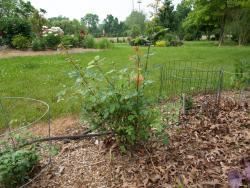Then I would assume, 'Pat Austin' is one fairly good example, of one Austin rose that a person truly wouldn't want, on "own roots", unless they sited it for a specifically limited area for growth.
Yes, I understand that some roses do have a genetic heritage whereby their stems are much thinner, & those with blooms which may like to be Winkin', Blinkin & "Nod."
I'm still trying to figure Annie's question; about how to answer the how's, why & when you'd select an "own root", or grafted, Then, if you'd select the same, or if different, then based upon what criteria ?
Annie, as you may realize by now, they may grow much larger in size, & faster too, when grafted.
Keep in mind, size stated & that may just be, after being pruned, once established.
If you wanted groupings of the same CV. I would probably use own root, although that may depend on how much area you want to cover, & that isn't even considering climbers (or those quite suitable to use them for that purpose.)
Some, you might could possibly use in large pots, if they're on the small side, & own root.
Have you ever had an Austin rose catalogue ?
I would recommend it, as it offers suggestions, for specific uses.
If you have plenty of space, & area to fill, perhaps grafted may work best
Then make use of smaller growing, on own roots, in more compact areas.
I found the same cultivar type, available in both type of roots, to arrive, nearly all the same sized bare root rose plants.
If you plan on ordering, do so early, to avoid disappointment of any being sold out (& suddenly at that.)
HTH

